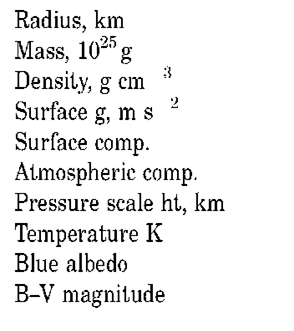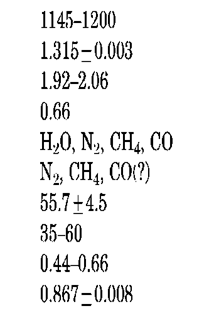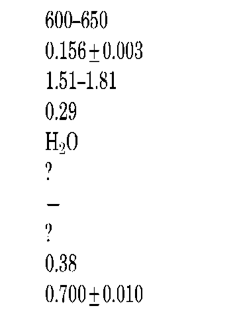Pluto and Charon: The Big Picture
Pluto is a small, cold planet on the outskirts of the known solar system. Pluto’s diameter (~ 2370 km) is roughly equivalent to the distance from New York to Las Vegas, or about two-thirds the size of our Moon. Pluto has one known moon of its own, Charon, whose diameter (~ 1250 km) is slightly more than half of Pluto’s. Unlike seven of the other eight planets (Uranus is the exception), Pluto rotates on its side, as does Charon in its orbit around Pluto. Charon’s distance from Pluto is 19,636 km, compared to the Earth-Moon distance of 384,400 km.
Despite their proximity, Pluto and Charon are covered by bright frosts of differing compositions: H2O ice covers Charon (1), whereas Pluto’s surface is predominantly N2 frost that has traces of methane and carbon monoxide ices (2). Both objects have densities near 2 gm/cm3 (3), implying a roughly even mixture of rock and H2O ice for their bulk compositions.
The Pluto/Charon system has a highly elliptical orbit around the Sun. At the time of Pluto’s perihelion in 1989, the system was less than 30 astronomical units (AU) from the sun, but the aphelion separation will be 50 AU in 2123. As Pluto recedes from the Sun, much of its thin N2 atmosphere will condense as frost on the surface. This periodic redeposition of fresh frost takes place every Pluto year (248 Earth-years) and is the reason that Pluto’s surface has one ofthe highest albedos in the solar system (4).
The Pluto/Charon system currently represents one of the wide open frontiers in the solar system. No spacecraft has visited Pluto/Charon (although NASA has plans for an upcoming Pluto-Kuiper Belt mission). The angular diameter of Pluto is only a tenth of an arcsecond at best, which is just about the resolving limit of the Hubble Space Telescope (HST) and ground-based observatories that have adaptive optics capabilities. Consequently much of what is known about the Pluto/Charon system has been pieced together from indirect clues or observations taken during unique observing geometries.
Observational Milestones: A Chronological Overview
Pluto’s discovery was due in large part to the efforts of Percival Lowell, who believed that a ”Planet X” must exist to account for so-called perturbations in the orbit of Uranus beyond those caused by the presence of Neptune. In point of fact, Pluto is much too small to cause perceptible perturbations in the orbits ofUranus or Neptune, and the residual ”perturbations” disappear when a more accurate mass of Neptune is used to calculate the Uranian orbit. Nevertheless, the prospect of finding a ninth planet motivated the astronomers of Lowell Observatory to mount three separate observational surveys, beginning in 1905 and leading to Clyde Tombaugh’s discovery of Pluto in 1930 (Fig. 1; (5)).
In the year after the discovery of Pluto, teams from around the world calculated the size and shape of Pluto’s orbit (Fig. 2). As the baseline of observations grew, it became apparent that Pluto’s orbit was unusual; its eccentricity was higher (0.25), its inclination greater (17 degrees), and its semimajor axis larger (39.44 AU) than that of any other planet.
Pluto’s bulk properties (e.g., size, rotational period, and surface composition) were more difficult to determine primarily because its magnitude (~ 13.3 at the time of discovery) was beyond the capabilities of early photometers and spectrometers. Rotational variations in Pluto’s brightness were first observed in the 1950s and led to the important conclusions that Pluto rotated every 6.39 days, and Pluto’s surface had distinct bright and dark regions that caused a 30% change in Pluto’s brightness as they rotated in and out of view. Because Pluto’s surface brightness was not known, its size could not be estimated from its observed magnitude. Early estimates of Pluto’s size assumed a dark surface (e.g., a 4% reflectance) and therefore vastly overestimated Pluto’s size and mass.
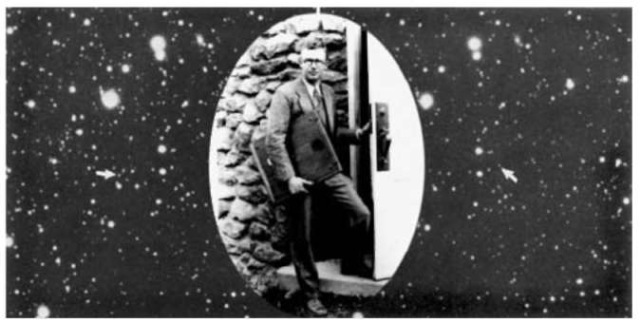
Figure 1. Clyde Tombaugh, the discoverer of Pluto, shown here at Lowell Observatory in Flagstaff, Arizona, entering a telescope dome with photographic plates in holders. The background shows two of the discovery blink plates. Pluto is much easier to find with the arrows, which unfortunately were not on the original plates (photos courtesy of Lowell Observatory).
In 1976, the first compositional identification was made; a crude spectrum of Pluto revealed the presence of methane (but not ammonia, H2O, or the other fully hydrogenated compounds of the common nonnoble elements C, N, or O) (6). The presence of methane ice suggested for the first time that Pluto was much brighter (and therefore much smaller) than previously suspected.
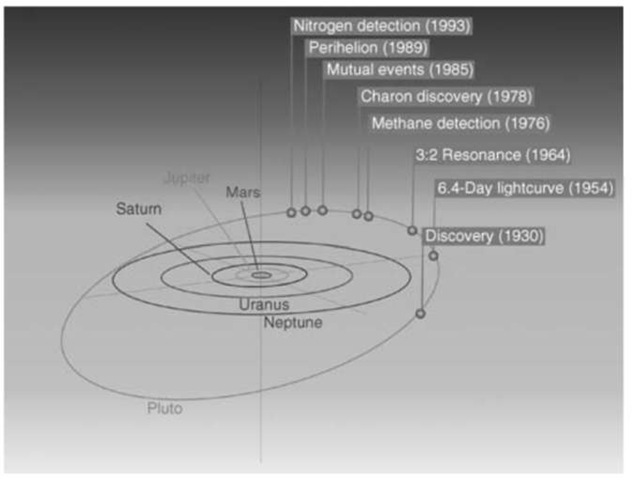
Figure 2. Pluto has traversed only about a third of its orbit since its discovery in 1930. The pace of discoveries has increased since the detection of methane frost on Pluto in 1976 and the discovery of Pluto’s satellite, Charon, in 1978. Some of the milestone discoveries are shown here.
In 1978, Pluto’s satellite Charon was discovered from photographic plates showing ”bulges” on the side of Pluto’s disk (7). A host of information followed from the regular series of eclipses of Pluto by Charon (and vice versa) (see section Mutual Events). The mutual events lasted from 1985 through 1990 and led to the first accurate determinations of the radii, masses, and densities of Pluto and Charon. Eventually, the first maps of the surfaces of Pluto and Charon were constructed from the mutual event light curves. The HST’s faint object camera (FOC) was used to image Pluto’s disk directly in the mid-1990s, albeit at a slightly lower spatial resolution (8).
In the 1980s, Pluto was observed by the infrared satellite IRAS at wavelengths that ranged from 25-100 mm. In the early 1990s, Pluto was observed at longer wavelengths (0.8 and 1.3 mm) from various ground-based submillimeter telescopes. In theory, each of these long wavelength observations should pin down Pluto’s blackbody temperature, but in practice, the IRAS fluxes indicate a much warmer surface than the submillimeter observations. A temperature-dependent spectral feature (see section Spectroscopy) is a third clue to Pluto’s surface temperature. In 1997, Pluto was observed by the ISO satellite (a European successor to IRAS), which confirmed that Pluto’s thermal emission at 60 and 100 mmis higher than one would expect, given the low submillimeter fluxes. Suffice it to say that Pluto’s temperature is currently controversial (see section Surfaces).
In 1988, Pluto was observed as it passed in front of a star (see section Stellar Occultation), an event which resulted in the discovery of Pluto’s atmosphere and determinations of Pluto’s vertical temperature and pressure profiles (9). Advances in spectroscopic instrumentation led to the discoveries of N2,CO, and CH4 ices on Pluto and H2O ice on Charon. Directly observed spectra of Charon without Pluto have been obtained only since 1998, using the spatial resolving capabilities of the HST’s NICMOS spectrometer or ground-based instruments using adaptive optics.
Orbital Dynamics. Pluto has the largest inclination and eccentricity of all of the nine planets (see Table 1). Pluto’s distance from the Sun ranges from 30 to 50 AU, and its vertical distance from the ecliptic plane ranges from ■—h 9AU to–14 AU. This large variation has significant implications for Pluto’s surface and atmosphere.
For 20 years of its 248-year period, Pluto is closer to the Sun than Neptune, most recently between 21 January 1979 and 14 March 1999. Although Pluto’s and Neptune’s orbits appear to cross in a bird’s-eye view of the solar system, Pluto never comes closer than 18 AU to Neptune. Whenever Pluto is ”inside” Neptune’s orbit, it is also several AU above Neptune’s orbit. More importantly, whenever Pluto is inside Neptune’s orbit, Neptune is always at least 70° away from Pluto in its own orbit. This special relationship between Pluto and Neptune is a manifestation of their 3:2 resonance (2 Pluto years are equivalent to 3 Neptune years).
The 3:2 resonance protects Pluto from close encounters with Neptune. If Neptune were to ”catch up” to Pluto (such that a collision seemed imminent), Pluto would initially lose angular momentum to Neptune. Pluto would then fall inward toward the Sun and in the process, speed up and pull away from Neptune (smaller heliocentric orbits have faster tangential velocities). It may seem counterintuitive that a loss in angular momentum results in a gain in tangential velocity, but examples of this resonant mechanism abound throughout the solar system (e.g., the coorbital satellites of Saturn). When Pluto ”catches up” to Neptune, the momentum exchange works in reverse.
Table 1. Summary3
Charon’s orbit around Pluto is nearly circular. Both objects continuously present the same face to each other (as our Moon does to Earth), a state called mutually synchronous rotation. In other words, a Charon day, a Pluto day, and a Charon month are all 6.39 Earth-days long. Pluto’s obliquity is close to 120° (compared to 23.3° for Earth), which means that Pluto’s spin axis lies fairly close to its orbital plane.
Masses and Radii. The mass of the Pluto/Charon binary is 1.471 ± 0.002 x 1025g, as determined from the period and semimajor axis of Charon’s orbit around Pluto. This is 454 times less massive than that of Earth, or more than a million times less massive than Jupiter. The individual masses of Pluto and Charon are less well known, but the current estimates are 1.315± 0.003 and 0.156 ±0.003 x 1025g. These can be combined with estimates of the radii to get the densities of these bodies. The best measurements for the radii come from the mutual events (see section Mutual Events), and give radii ranging from 11451200 km for Pluto and from 600-650 km for Charon. These radii are also consistent with stellar occultations (see section Stellar Occultation), but for one caveat. The possibility exists that the mutual events are detecting the altitude of a haze layer instead of the surface, in which case Pluto’s true surface could lie well below the observed radius. If we ignore this possibility for the moment, we find that Pluto’s mean density is 1.92-2.06 g/cm3 and Charon’s is 1.51-1.81.
Pluto and Charon have densities roughly halfway between that of water ice (~1g/cm3) and rock (~3g/cm3). Whether Pluto’s interior is differentiated or homogeneous depends on Pluto’s thermal history. Differentiation is a runaway process; once started, it generates heat that allows rock to migrate through ice to the planet’s core, ending with a rocky core and icy mantle. Current models of Pluto predict a differentiated rocky core comprising 53-71% of the total mass (10), although an undifferentiated Pluto cannot be ruled out at this time. The uncertainties in Charon’s density are large enough that we cannot say at this point whether or not Charon’s interior is undifferentiated. Surfaces. Pluto has one of the brightest and most variegated surfaces in the solar system. Two techniques are used to map Pluto’s surface: direct imaging using HST’s faint object camera (FOC) and an indirect technique based on observations taken during transits of Pluto by Charon (see section Mutual Events). Both techniques show some extremely bright regions (predominantly N2 frost), often adjacent to very dark regions (composition unknown) (Fig. 3).
Some of the most noticeable features of the mutual event map are a large bright frost-covered region over the southern latitudes (ranging from the pole to around 45° S), an adjacent dark region just south of the equator, a very bright patch at 17° N, and a North Polar region that has an albedo near Pluto’s average of 0.5, much darker than the typical southern albedo.
Because Pluto’s angular diameter is about 0.11 arcsec (equivalent to a 25-cent piece viewed from a distance of 25 miles), its disk is a challenging target for the FOC. The point-spread function of the FOC has a full width at half maximum (FWHM) that is roughly 0.03 arcsec, only one-third to one-quarter of Pluto’s diameter. It is possible to improve on the instrument’s spatial resolution by combining FOC images taken at several rotational phases. Unlike the mutual event maps, the FOC map covers all longitudes of Pluto’s surface, not just the sub-Charon hemisphere. A comparison of the two maps confirms the presence of a bright South Polar feature, although the mutual event map shows a much larger southern frost-covered region. Both maps show a dark latitudinal band south of the equator, but the bright feature at 17° N in the mutual events map seems to be spread into a wider bright feature in the northern latitudes of the FOC map.
Parts of Pluto are extremely bright, suggesting a layer of recently deposited frost. The bright regions are almost certainly composed of N2 frost and traces of CH4 and CO ice (see section Spectroscopy). One of the continuing mysteries, however, is why certain areas are bright and others are not. Pluto’s South Pole was in continuous sunlight for most of the past century, yet it remains the largest frost-covered region on the planet. In contrast, the North Pole has been in continuous shadow and ought to be the site where atmospheric N2 would preferentially condense onto the surface. Surprisingly, it is not nearly as bright as the southern part of the planet. Thereisanintimaterelationshipbetweentheatmosphereandthealbedodistri-bution of the surface that is not yet understood (see section Volatile Transport).
Pluto’s average surface temperature results from the balance between absorbed sunlight and radiational cooling. On local scales, the surface temperatures are also affected by ongoing condensation or sublimation (see section Volatile Transport) in addition to variations in surface brightness and thermal coupling to subsurface layers. It is currently thought that the N2 frost temperature is 35.6 K across the entire sphere (11), but regions that have less volatile veneers may reach higher temperatures.
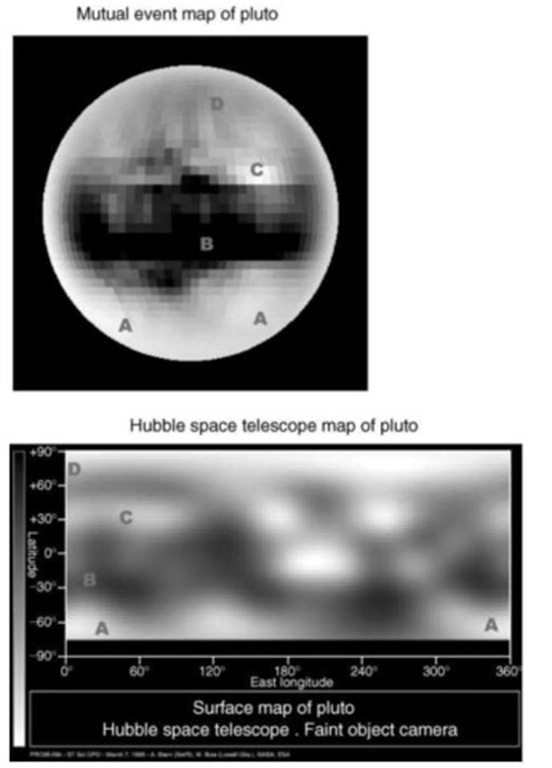
Figure 3. Pluto is a challenging target, even for the Hubble Space Telescope (HST). The highest resolution maps are derived from mutual event light curves (19), but they cover only the part of Pluto’s disk that is always below Charon. To compare the mutual event and the HST maps, bear in mind that the center of the mutual event disk is the line of zero longitude, or the left-hand edge of the HST map. Both maps show the presence of a bright southern frost region (A) bordered by a dark band (B). There is a very bright patch at around 17° N (C). Surprisingly, the Northern Hemisphere (D) is only slightly brighter than the average albedo, even though this region should have been a condensation site during the past few decades. (The HST map courtesy of M. Buie, Lowell Observatory).
Atmospheres. Pluto’s atmosphere is composed primarily of N2 and trace amounts of CH4, CO, and photochemical by-products. Because N2 can exist in both gaseous and solid phases near Pluto’s cold surface, the atmosphere is expected to be in vapor pressure equilibrium with the surface. Vapor pressure equilibrium means that the surface pressure is a function of surface temperature (an extremely steep function in the case of N2, CO, and CH4; see Volatile Transport). A drop of only 4 K (from 40 K to 36 K, for example) results in a 10-fold drop in pressure (from 58 ubar to 5.4 mbar) (12).
Of the three species seen in the surface spectra, N2,CH4, and CO, N2 is by far the most volatile and should therefore dominate the atmospheric composition. CH4 and CO should also be present in the atmosphere in trace amounts. At the cold temperatures of the outer solar system, subsurface H2O is as volatile as a rock in your backyard, and no gaseous H2O is expected to be present in the atmosphere. Gaseous CH4 has been detected directly in near-infrared spectra and probably forms about 0.1% of the mass of the atmosphere. The vertical distribution of CH4 is unknown; a few hundred km above Pluto’s surface, CH4 may be depleted due to photochemical destruction, whereas at high altitudes, its relative abundance should rise again as CH4 diffuses through the heavier N2 gas. The fraction of CO should be relatively constant with height because it is less strongly involved in photochemical reactions and because the molecular weight of CO is equal to that of N2. To date, only an upper limit of 7% has been placed on the abundance of CO in Pluto’s atmosphere. However, we can estimate that CO is present in trace amounts (perhaps near ~0.04%) from the amount of CO seen in the surface.
The thermal structure of Pluto’s atmosphere has been detected directly from about 0.1 to 2.3 mbar (around 1410 to 1215 km in radius) (see section Stellar Occultation). In this region, the atmosphere is nearly isothermal and has a temperature of 102 7 9 K. At 1215711km, (2.33 + 0.24 mbar), the atmosphere undergoes a discontinuity. Below this level, either the atmosphere contains absorbing hazes, or the temperature dives sharply, at roughly 10 K/km, to reach the colder surface temperatures below.
The chemistry of Pluto’s atmosphere is highly uncertain due to the unknown ratios of the trace molecules. We can look to the atmospheres of Triton and Titan as a guide because they also consist primarily of N2 and trace amounts of CH4.
The energetic UV photons from the sun are expected to dissociate gaseous N2 and CH4, which will recombine to form heavier hydrocarbons (C2H2,C2H6, C2H4,C4H2) and nitriles (HCN, C2H3CN, C4N2), as well as light by-products [H, H2,C,C2, N, NH, NH2D]. Most of the hydrocarbons and nitriles are expected to condense, forming a thin smog in Pluto’s atmosphere and eventually settling through the tenuous atmosphere to the surface. To date, the photochemical products have not been reliably detected. The rate of predicted haze production is too low to explain the discontinuity in the stellar occultation light curve. The lighter species and some of the lighter hydrocarbons will diffuse upward and either escape or participate in ionospheric chemistry. Models of the ionosphere predict a peak in the ion density between 1 nbar and 10 pbar, located at roughly one Pluto radius above the surface, that is composed of the ions N+ ,C+ ,N2h, CO + ,C2H+, and CH+ (13). The identity of the major ion depends on the composition of the neutral atmosphere. For example, if CO is essentially absent, then the ionosphere will be primarily N .
Even trace amounts of CO and CH4 in the atmosphere have a large effect on the temperature of the atmosphere. CO acts as a universal coolant by absorbing thermal energy through collisions and reradiating it away (rotational cooling). In contrast, CH4 absorbs radiation at 2.3 and 3.3 mm and reemits at 7.7 mm. These absorption and emission rates are temperature sensitive and balance at a temperature of 106 K (14). The net result is that CH4 tries to act as a thermostat that pegs the temperature of the middle atmosphere to ~ 100 K.
Origin Scenarios
The Pluto/Charon binary is such an unusual system that one wonders how it came to be. Specifically, where in the solar system did Pluto form? How did Pluto become a binary system? And how did the Pluto-Charon binary find itself in the safe haven of the 3:2 resonance? As discussed previously [see Masses and Radii], Pluto’s bulk density constrains the fraction of ice and rock that composes Pluto’s interior. This, combined with cosmochemical models of the composition of plan-etesimals in the early solar system, implies that Pluto formed in the outer solar system, probably past 10 AU.
Pluto is currently in a stable resonance with Neptune. Running time backwards, we see that a hard niche to leave is also a hard niche to enter. There are two scenarios for the insertion of Pluto into the 3:2 resonance. Either Neptune moved outward to capture Pluto, or Pluto experienced one or more damping events, perhaps as collisions with a then-larger population of similar small bodies.
More than 100 small objects in Pluto-like orbits have been discovered since 1992. From a strictly dynamical standpoint, Pluto and Charon are the two largest known members of the Edgeworth-Kuiper Belt (EKB). It is not yet known whether Pluto and Charon were formed by the same processes as the rest of the EKB, or whether they formed elsewhere in the solar system.
The current standard model for the formation of the Pluto/Charon binary is by a giant impact, which could also explain Pluto’s large obliquity. The giant impact scenario supposes that a proto-Pluto was impacted by a large interloper. The scattered debris rapidly reaccreted into the present-day Pluto and Charon, albeit the orbit for Charon was far different. The circularization of Charon’s orbit and the evolution of the mutually synchronous spin periods are expected to take place on a ~ 100-million-year timescale as a result of tidal dissipation. The alternative formation hypotheses generally have one or more fatal flaws, such as: Fission of a Rapidly Spinning Molten Body. It is unlikely that a proto-Pluto was spun up by the accretion of small impacts to the point that it split into a Pluto-Charon pair. Among other considerations, if the spin-up process were not extremely rapid (i.e., not a single large impact!), then the rapidly rotating proto-Pluto would tend to damp out any bar-shaped perturbations to its shape and return to an axially symmetrical state.
Intact Capture of Charon by Pluto. This hypothesis requires some shortlived mechanism by which a rogue Charon’s velocity (relative to Pluto) is decreased, such as tidal dissipation, collision with circumplanetary debris, or a collision with a third body. All of these mechanisms are extremely unlikely. Coformation of Pluto and Charon. Could a proto-Pluto acquire a ring of material (from planetismals colliding nearby) from which Charon could form?
Unlikely, because it is difficult to create a ring that has the angular momentum seen in the current Pluto/Charon binary.
Mutual Events
Shortly after the discovery of Charon in 1978, it was realized that Charon’s orbit was oriented nearly edge-on toward Earth. In 1985, the first transits of Pluto by Charon were observed, and for the next six years, Charon transited in front of Pluto (interspersed with Pluto occultations of Charon) every 6.39 days. Charons’ transit path across Pluto migrated from the northern latitudes in 1985 and 1986 to the southern latitudes in 1989 and 1990.
The 6-year series of transits and occultations are collectively called the mutual events. Once the Pluto-Charon separation was measured (initially by high-spatial-resolution speckle interferometry in 1980), the timing of the beginning and end of events provided the first reliable way to measure Pluto’s and Charon’s radii. (The average density of the Pluto/Charon system was one of the first mutual event results because it is a function of the timing alone and does not depend on their separation). After Charon’s orbit around Pluto was determined, the mutual events could be used to build the first maps of Pluto’s surface.
Pluto and Charon obscured each other regularly every 6.39 days throughout the mutual event season (1985 through 1990). Although both objects were too small to resolve, it was easy to see the system brightness decrease as part of Pluto was covered up. An event typically lasted from 1-4 hours; during that time, the Pluto/Charon brightness might decrease by as much as 60% and then return to normal levels. If you could keep track of which part of Pluto was covered at any time and you knew the amount of dimming that took place when that part was covered up, you would know the surface brightness of the covered-up region. After observing a number of transits, you could piece together a brightness mosaic of Pluto (Fig. 4). More precisely, you could map half of Pluto by this technique. Just as our Moon always shows only one side to Earth, Pluto and Charon are locked in a mutually synchronous rotation, which means that Charon always transits the same face of Pluto.
Spectroscopy
Much of what is known about Pluto and Charon lies in the details of their infrared spectra. On Pluto, the most obvious constituent is CH4, followed by CO and N2 (2). On Charon, the only certain surface frost is H2O, although NH3 has been suggested as a trace constituent (15). Pluto is one of the redder objects in the solar system. It is currently thought that UV radiation photolyzes CH4 and N2 into larger hydrocarbons, similar to the processes in smog-producing regions on Earth. These pho-tolytic by-products have been produced in the laboratory but have not yet been identified in the spectra of Pluto or Charon. In the lab, they are initially red in color and become brown or black as they undergo more photolytic processing.
The most prevalent surface frost on Pluto happens to have the weakest spectral signature. The 2.14-mm absorption feature of N2 is barely detectable in Pluto’s spectrum, but the intrinsic band strength is so low that its mere presence means that the surface frost on Pluto is at least 95% nitrogen ice. Furthermore, the shape of the N2 spectral feature changes with temperature, a fact that has been exploited to use Pluto’s spectrum as a thermometer. Lab work performed in the early 1990s suggested that the N2 absorption feature matched a frost temperature of 40 + 2 K (16), but more recent laboratory spectroscopy suggests that 36 K is a closer match (11). N2 has a phase transition at 35.6 K as it changes from a cubic to a hexagonal crystal. It is possible that subsurface N2 ice undergoing this phase change acts as an energy storage mechanism and thereby maintains a frost temperature near 35.6 K. It is worth pointing out that a difference of a few degrees in the N2 frost temperature has an enormous effect on the total mass of Pluto’s atmosphere because the N2 vapor pressure is an extremely steep function of temperature (see Volatile Transport).
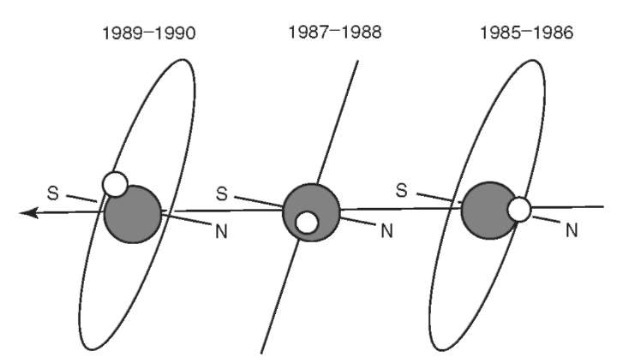
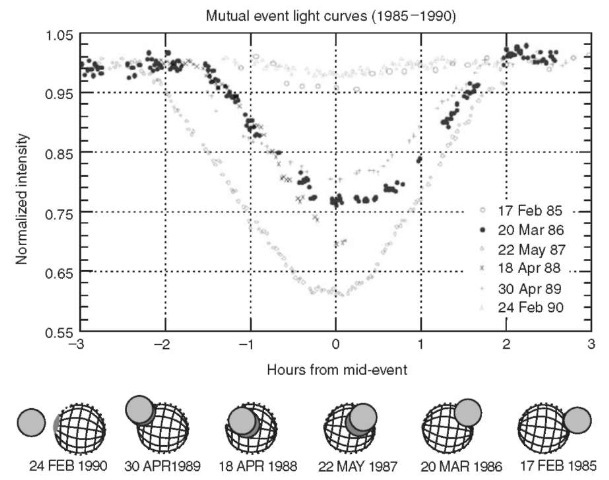
Figure 4. From 1985 through 1990, Pluto and Charon occulted or transited each other nearly weekly, a series that is collectively called ”mutual events.” These produced a host of results, including new estimates for the sizes of Charon and Pluto, the orbit of Charon, and even a crude map of Pluto’s surface.
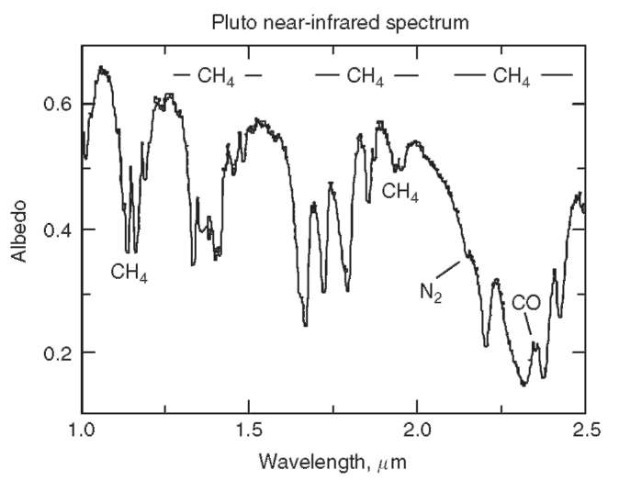
Figure 5. Pluto’s infrared spectrum shows the presence of nitrogen, methane, and carbon monoxide frosts.
CH4 absorption features dominate Pluto’s spectrum. The spectroscopy of Pluto shows two distinct components of CH4, one frozen in an N2 frost matrix and one nearly undiluted (17). CH4 is about 10,000 times less volatile than N2 and CO at Pluto’s temperatures, so it is conceivable that some separation of volatiles occurs as different molecules condense onto or sublimate from the surface under different conditions (Fig. 5).
Since the early mutual events, it has been known that Charon’s surface is primarily H2O ice. Spectra obtained in the past year of Charon without Pluto show that the H2O ice is crystalline rather than amorphous. This finding is somewhat surprising because irradiation by electrons, fast protons, or UV photons will transform crystalline ice into amorphous ice over time, provided that the ice temperature is lower than 70-80 K. The fact that Charon is predominantly covered with crystalline ice implies that Charon experienced a recent resurfacing event or that Charon’s surface somehow reaches temperatures that are high enough to allow the amorphous-to-crystalline transition.
Stellar Occultation
Pluto occasionally passes directly between Earth and a star. These events are called stellar occultations, and they represent rare opportunities to study Pluto’s atmosphere. In practice, these events are hard to observe; they require a star that is comparable to Pluto’s brightness (e.g., fourteenth magnitude or brighter) and extremely accurate relative positions between Pluto and the star (Fig. 6).
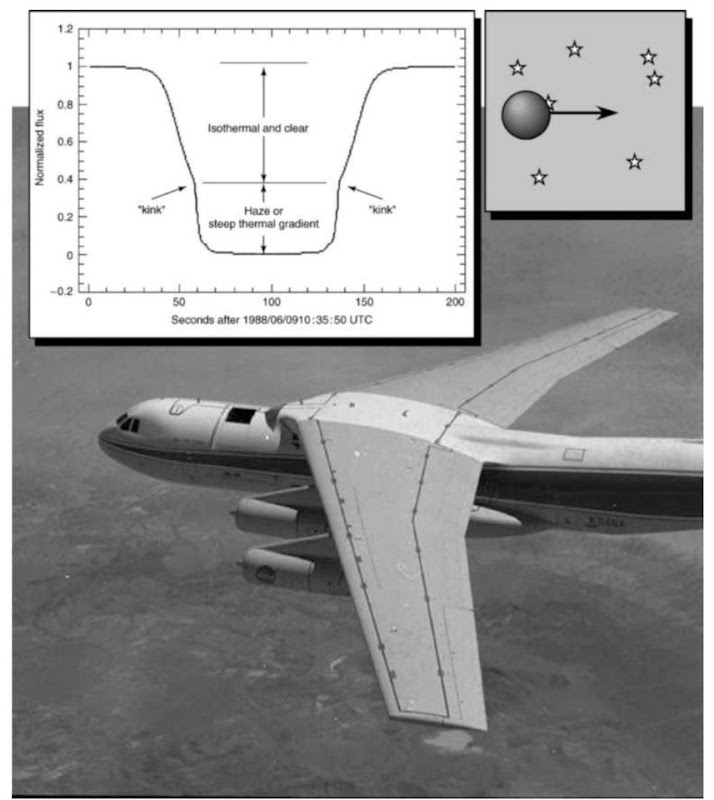
Figure 6. Occasionally, Pluto moves briefly in front of a background star in an event called a ”stellar occultation.” One of the best occultation light curves was obtained from NASA’s Kuiper Airborne Observatory, a modified C-141 housing a 1-meter telescope. An unusual feature in Pluto’s occultation light curve is the sudden change in slope (the ”kink”) that occurs partway through both the stellar ingress and egress. Possible explanations include a haze layer or a thermal inversion in Pluto’s lower atmosphere.
Pluto casts a fast-moving shadow that is the size of its disk. This shadow typically crosses a ground station in about a minute. The key to observing a stellar occultation is being in the right place at the right time; the shadow path predictions often jump by thousands of km as calibration observations of Pluto and the target star refine the track of the shadow’s path. Often observers find themselves with airline tickets to exotic places, only to find that the shadow no longer intersects Earth at all! Given these difficulties, it is not surprising that there has been only a single successful observation of a stellar occultation by Pluto to date.
On 8 June, 1988, Pluto moved in front of a twelfth magnitude star. If Pluto had had no atmosphere, the light from the star would have blinked out abruptly as Pluto’s disk blocked the star (and would have reappeared equally abruptly moments later). However, the starlight faded gradually. This event marked the discovery of Pluto’s atmosphere.
The 1988 occultation provides the most detailed and direct information we have about Pluto’s atmosphere. Most of the star’s initial disappearance is not due to Pluto’s atmosphere blocking the light, but rather due to Pluto’s atmosphere acting like a lens that spreads out the light, differential refraction caused by the exponential vertical profile of atmospheric pressure. At the initial stages of the occultation, before the star has been attentuated to the half-light level, the light curve follows a shape consistent with Pluto’s atmosphere being clear and nearly isothermal. There is a discontinuity at the half-light point beyond which the rate of attenuation suddenly becomes steeper. The interpretation of this ”knee” in the light curve is currently ambiguous; it could be caused by an absorbing haze layer, a steep thermal gradient (which changes the refractive properties of the atmosphere across a range of altitudes), or a combination of the two (18).
Volatile Transport
Although Pluto’s atmosphere is currently a meager 40 mbar, it is sufficient to transport volatiles across Pluto’s surface. Pluto’s atmosphere and surface frosts form an intimately coupled system, primarily because the active volatile species (N2, CO, and CH4) have vapor pressures that are extremely steep functions of temperature.
We believe that the general transport of volatile materials on Pluto follows a simple rule: frost sublimates from Pluto’s sunlit side and condenses on its shaded side. Weather prediction on Pluto ought to be equally simple: the prevailing winds should always blow radially outward from the subsolar point. To see why this must be so, consider a patch of N2 frost on Pluto’s daytime hemisphere. The long day tends to heat up the frost patch, but any rise in temperature, even by a degree or two, would result in a dramatic rise in the local surface pressure. Large pressure gradients cannot be sustained; instead there is a local flow outward from the sunlit region.
A side effect of the steep vapor pressure/temperature relation is that the entire frost-covered areas of the planet should maintain a single global temperature. The sunlit regions are cooled by the latent heat of sublimation of N2 frost, and the shaded regions are warmed by the latent heat of condensation. A local frost patch cannot grow too warm or too cold; that would imply an unsustainable pressure excess or deficit in that neighborhood. The global frost temperature model breaks down only if Pluto’s atmosphere is too rarified to propagate pressure gradients from the dayside to the nightside (as is so around the volcanos of Io, for example). In the rarefied atmosphere, local atmospheres freeze out on the cold, shaded surface before reaching all parts of the planet, even though the flow emanates at supersonic velocities from its sources. Pluto’s atmosphere is currently thick enough to equilibrate frost temperatures across the entire surface, but as Pluto recedes from the Sun in the coming century, its atmosphere may freeze out to the point that only a local, dayside atmosphere remains. If that does occur, the nightside frosts will become significantly colder than the dayside frosts. It is important to note the shortcomings of the simple sublimation-balance model. The most significant problem is that the present frost distribution does not match the model’s predictions for frost deposition on the North and South Polar regions. Because Pluto rotates ”on its side,” the South Pole experienced a long summer (up to 124 years of continuous sunlight) until 1989, yet the South Pole was not devoid of frost. On the contrary, the Southern Hemisphere appears to be the site of Pluto’s largest frost reservoir. The predicted depth of new frost in northern latitudes is roughly 1m during the 124-year northern winter, easily enough to change Pluto’s albedo. Yet such an albedo change is not apparent in the mutual event maps. A more detailed frost transport model is necessary that accounts for the numerous influences on the surface temperature, the horizontal transport of sublimated N2, and the microphysical state (e.g., porosity) of the surface frost.
